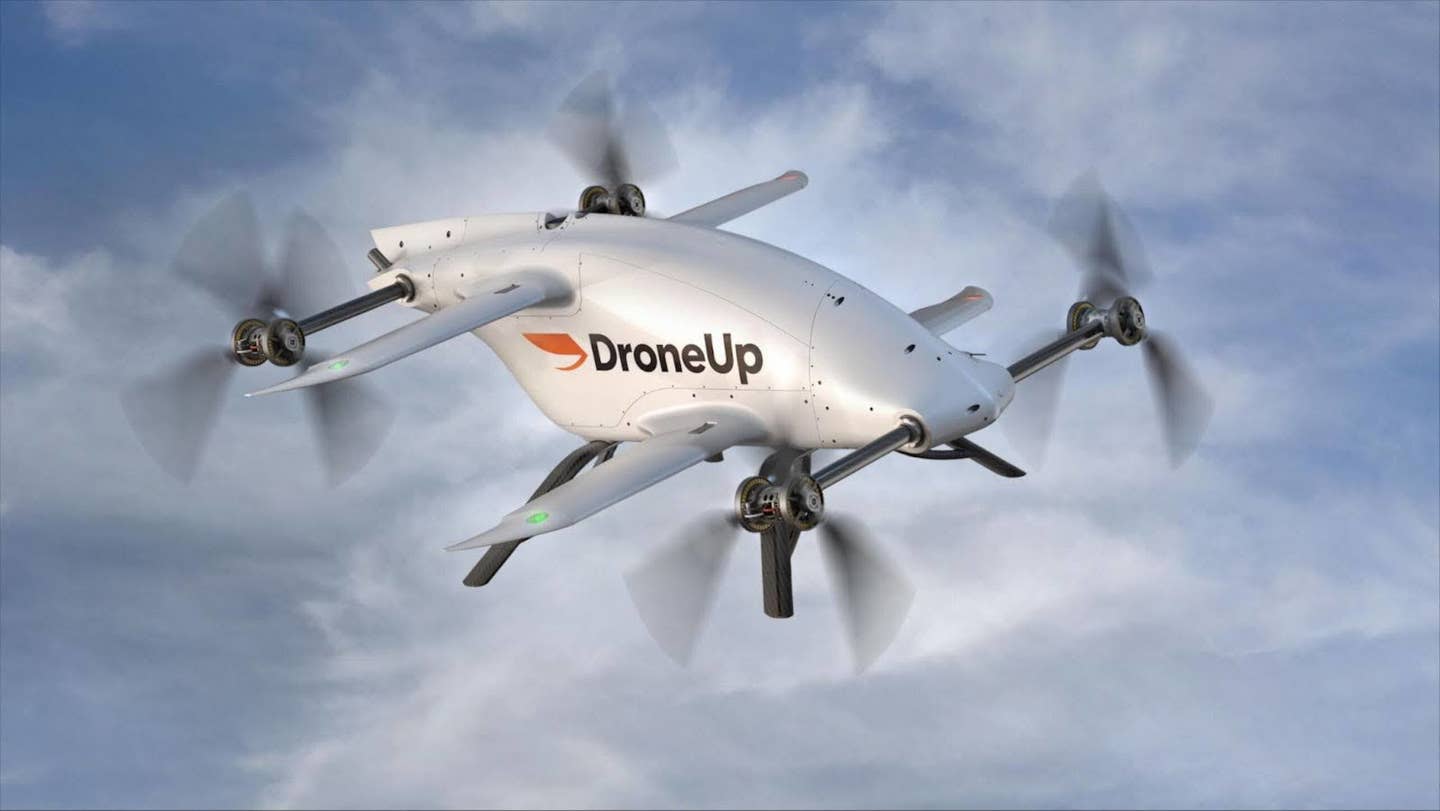Walmart Partner DroneUp Introduces Autonomous Ecosystem
The DroneUp Ecosystem includes a next-generation drone platform, autonomous software, and ground infrastructure.

DroneUp’s next-generation drone is only one piece of the company’s Ecosystem offering, which also includes ground infrastructure and automated software. [Courtesy: DroneUp]
Longtime Walmart drone delivery partner DroneUp has unveiled its latest autonomous offering.
The company on Tuesday introduced its drone Ecosystem, a suite of ground, air, and software products wrapped into a single platform to enable drone delivery for retailers, healthcare providers, restaurants, and other customers. According to DroneUp CEO Tom Walker, the firm will roll out the solution next quarter and continue adding locations over the next 18 to 24 months.
Walker says the DroneUp Ecosystem is the first fully automated end-to-end drone delivery system. It combines a suite of software operating systems, two next-generation drones, and automated ground infrastructure, which the company believes will make its services more scalable, accessible, and affordable.
In partnership with DroneUp, Walmart operates a network of 36 hubs based out of stores in Florida, Texas, Virginia, Arkansas, Utah, Arizona, and North Carolina. The world’s largest retailer is also working with drone delivery firms Zipline, Flytrex, and Alphabet’s Wing.
In addition, DroneUp has relationships with state agencies in Utah, Hawaii, Iowa, Florida, and Rhode Island.
“Our work with leading retailers and quick-service restaurants has provided us with valuable insights into the speed and convenience that end customers desire from drone delivery,” said Walker. “Our Ecosystem is designed to exceed those expectations, enabling us to perform millions of deliveries daily.”
The DroneUp Ecosystem comprises three components. On the ground is DBX, a secure outdoor locker with climate-controlled package management that can be stored in spaces smaller than a parking spot. DBX will enable autonomous package pickup and returns for customers. The locker can be reconfigured in a variety of ways, capable of being installed on the side of a building or rooftop. Depending on the configuration, it can hold as many as 100 packages.
The company’s two next-generation drones will be able to land automatically and precisely on top of DBX. The smaller model flies at 60 mph for up to 30 sm (26 nm), which DroneUp says gives the Ecosystem a 15-mile service coverage radius around integrated vendors. It can carry up to 10 pounds of cargo. A higher endurance model can fly for 100 miles round trip and accommodate heavier payloads. Both aircraft are designed to complete deliveries in less than 30 minutes.
The drones come equipped with internal package storage for rain, snow, and sun protection, and are capable of flying in winds as fast as 30 knots. DroneUp says the next-generation models will have industry-leading size and weight capacity to support a higher volume of orders than ever before. In addition, Walker notes they will make about as much noise as a refrigerator when flying at delivery altitude.
Onboard charging technology eliminates the need for ground personnel to swap out the drones’ battery packs, giving them more uptime. Onboard vertical clearance sensing, meanwhile, automatically determines the drone’s height over obstacles. At the delivery site, the drone can release a claw-like package grasper to perform aerial drops or winch up to 120 feet, enabling autonomous pickup and drop-off.
Crucially, the drones can fly from a DBX to a customer’s home or between the outdoor hubs. The automated lockers will be deployed as delivery sites in urban areas to serve apartments, college campuses, office buildings, and other hard-to-reach locations.
The process is simple. A retailer packs and places the order in the DBX, which autonomously secures and prepares it for pickup. The locker then opens its top for a drone’s winch to grab the package. Once the order arrives at another DBX, customers can scan a code or use a mobile app to complete an identification verification process and retrieve it.
Orchestrating the drones and ground infrastructure is an autonomous flight planning and control application. Walker points out that DroneUp operators will function like air traffic controllers, monitoring swaths of airspace rather than individual drones. This will allow a single operator to supervise multiple flights.
The autonomous flight planning system includes digitized maps and advanced flight coordination features, such as detect-and-avoid technology, which DroneUp maintains will enable flights beyond the visual line of sight (BVLOS). The company in January obtained FAA approval to fly BVLOS without stationing human observers along routes, joining a handful of firms that also includes Zipline and Wing.
The software’s multidimensional pathfinding system allows drones to fly around, over, or under obstacles, adjusting routes accordingly. The cloud-based system can also accommodate surges in demand by allocating drones to areas with high activity.
The Ecosystem is not DroneUp’s first foray into automation. In 2023, it partnered with Iris Automation to build what is essentially an air traffic control system for uncrewed drones. The company will deploy Iris’ ground-based, detect-and-alert system across a network of “nodes” spread throughout its delivery areas. Much like cellphone towers, these will communicate airspace traffic data to improve BVLOS visibility.
Like this story? We think you'll also like the Future of FLYING newsletter sent every Thursday afternoon. Sign up now.

Subscribe to Our Newsletter
Get the latest FLYING stories delivered directly to your inbox






